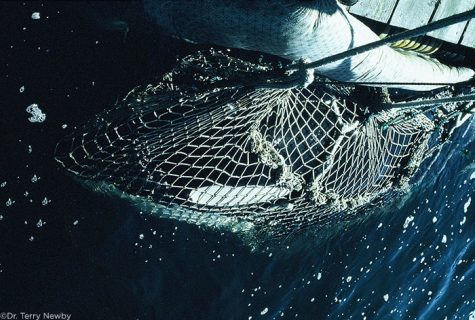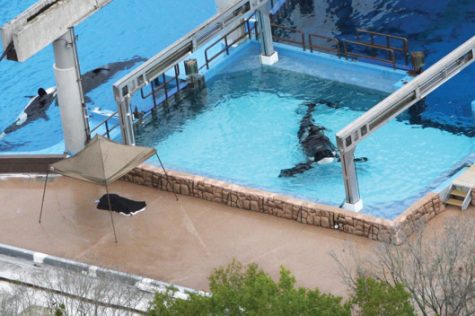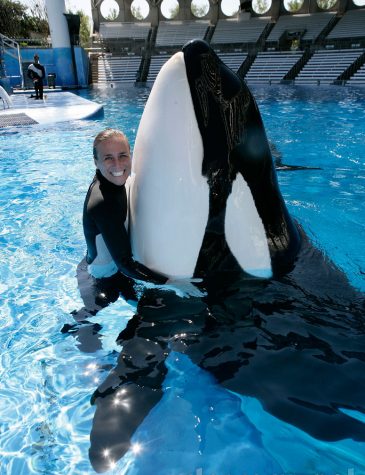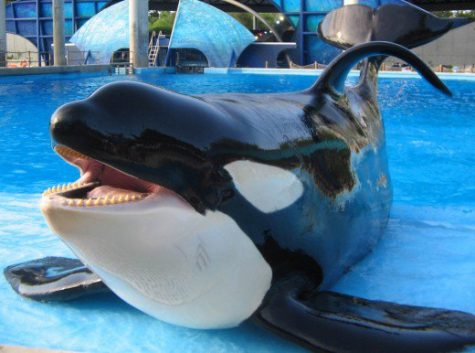Tilikum: Finally Free
Sea World is a chain of animal theme parks that includes a variety of activities. One of their main attractions happens to be their extravagant orca shows. But what if you looked beyond the what seem to be happy whales and amazing tricks, what would you really find? More and more people are beginning to take notice of this question.
One whale in particular named Tilikum really grasped the attention of the nation. Tilikum had been responsible for three human deaths at Sea World. A documentary entitled “Blackfish” featured Tilikum and his life in captivity. This documentary caused the public to feel more sympathy towards Tilikum and not view him as the monster that most would portray him to be.
A while after the documentary was released, the uproar about the whales in captivity began to die down. But, on January 6 of this year the protest began again as it was reported that the 12,500-pound killer whale Tilikum had died. This tragic events is now leading to an abundance of investigations into Tilikum’s life.

Tilikum was captured near Iceland in November of 1983 when he was only two years old. But, capturing these massive whale is much more tragic than it seems. Once a pod of orcas is found, the boatmen will circle them and heard that pod into a more maintainable space. Then, nets are thrown in, dividing the orcas, separating mothers from their young. Deafening explosives are also used to scare the orcas into the captors traps.
Terry Newby, a young marine mammal researcher traveled alongside some of the hired actors during a few of their missions. Dr. Newby has said that he can still hear the orcas screaming, speaking for their family, shrilling as they try to escape. The orcas lift themselves out of the water in hopes of being saved by family members. The killer whales are then pulled input into slings, and lifted on to the boat.
After Tilikum was captured, he was put into a cement holding tank at Hafnarfjörður Marine Zoo, near Reykjavík, Iceland for close to a year while he was awaiting transfer to a marine park. Then, the time came for Tilikum to move out of Iceland and into show business. He was transferred to Sealand of the Pacific in British Columbia, Canada. Here he would call a 100-foot-by-50-foot small pool which was only 35 feet deep his new home
Even though Tilikum ventured out into slightly bigger pools for performing, his life was continuing on a downward spiral. He was forced to perform every hour, eight times a day, seven days a week. SeaWorld veterinarians say that the constant exhaustion and stress gave him stomach ulcers. The constant stress is also why you saw that Tilikum had a collapsed dorsal fin. This is a sign of an unhealthy orca. It is caused by the unnatural environment of captivity. This condition is very rarely seen in the wild.
At Sealand, Tilikum was not alone. He often performed with two other female orcas named Haida and Nootka. All three of them were often kept in the same holding pools. When practicing for a performance, if Tilikum were to do a trick wrong, food would be withheld from the orcas. Due to this and the stress of the cramped spaces, Haida and Nootka would often gang up on Tilikum. He would endure grueling attacks, which left him scarred.
The terrible treatment that was pushed towards Tilikum changed him. He grew to be grumpy, irritated, and violent. On February 21, 1991 Tilikum attacked his first victim, Keltie Byrne. During a performance, the orca battered Byrnes to death. After this tragic incident, SeaLand closed it’s doors and sold many of their killer whales to Sea World. But, being moved to a different park did not diminish Tilikum’s newfound, violent nature. At Sea World Tilikum produced two more attacks. One of them was the attack upon Daniel P. Dukes in 1999. Dukes had snuck into the park and into one of the whale enclosures at night after closing. When workers came back in the morning, they found Dukes lifeless across Tilikum’s back. The second attack was on trainer Dawn Brancheau in 2010. During a show, Tilikum Brancheau into the tank scalping her and leaving multiple wounds in her body. After this attack, SeaWorld implemented the new rule to where the trainers were no longer allowed to be in the tank while the orca was present.
SeaWorld claims that Tilikum pulled Dawn in by her ponytail which distracted and frightened the whale. Now, many claim this statement to be untrue. Pictures and videos around the time of the accident show that Tilikum was towards the front of Brancheau, her ponytail was well out of the whale’s line of sight. This leads some to believe that there was something else going on in Tilikum’s mind. Also, the theme park waited 27 minutes to call 911 after Brancheau was pulled into the water. Why did they wait so long to call for help, was it to protect their own reputation over the life of a trainer? If we can’t trust Seaworld to protect their own trainer, we can’t trust them to protect and advocate for the safety and well-being of their captive animals.
Dawn’s death surprised everyone at SeaWorld. She had a special and close relationship with the whales, especially Tilikum and loved them as if they were her children. But, these animals should not be depicted in a violent way. Naomi Rose, a marine mammal scientist with the Humane Society of the U.S who had studied Tili kum’s behavior states, “It’s not his fault what happened, just as it wasn’t Dawn Brancheau’s. The fault lies with using these wild animals as entertainment…this was an accident waiting to happen.” Rose’s comment check out to be true. There has been no recorded instance of an orca whale killing someone in the wild. This leads researchers to believe that captivity must be the root of the problem. Tilikum was often found floating motionlessly in his tank which is never seen by orca whales in the wild.
kum’s behavior states, “It’s not his fault what happened, just as it wasn’t Dawn Brancheau’s. The fault lies with using these wild animals as entertainment…this was an accident waiting to happen.” Rose’s comment check out to be true. There has been no recorded instance of an orca whale killing someone in the wild. This leads researchers to believe that captivity must be the root of the problem. Tilikum was often found floating motionlessly in his tank which is never seen by orca whales in the wild.
Captivity is limiting killer whale’s lives. Tilikum swam circles in .0001 percent of the quantity of water that he would travel in a single day in nature. His teeth had also been grind down no basically nothing, this is due to the orcas chewing on the concrete perimeter of their enclosures. The Whale and Dolphin Conservation Society states that it is time to recognize that keeping animals up to 26 feet long in small, cramped tanks was no longer acceptable. “The spaces are inadequate, the psychological damage is deep. These are highly social, long-distance acoustic animals who are harmed by living in concrete pens.”
The cause of Tilikum’s death was a persistent and complicated bacterial lung infection. While this is the literal, medical cause of his death, his life truly ended along time before this. In this case I am talking about the whale’s emotional state of being torn away from his family and confined in small tanks for his entire life. Only 20 of the 145 orcas taken into captivity are still alive today. The effects of being in captivity is when started Tilikum’s trail to his death. Many orcas are ripped from their families each year only to be placed into deplorable conditions that cost them a shorter life. Hopefully, Tilikum’s death will inspire others to help make a difference in these whales’ lives.











Anthony Magno • Feb 17, 2018 at 1:49 pm
Let them all go…
Too big for a prison cell..There are ways to observe,study and appreciate these wonderful creatures